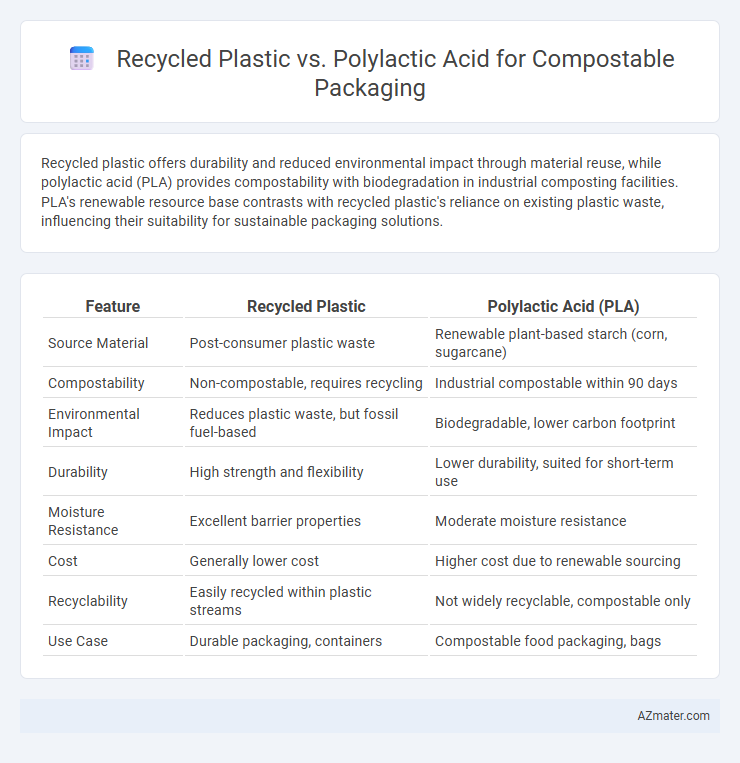Recycled plastic offers durability and reduced environmental impact through material reuse, while polylactic acid (PLA) provides compostability with biodegradation in industrial composting facilities. PLA's renewable resource base contrasts with recycled plastic's reliance on existing plastic waste, influencing their suitability for sustainable packaging solutions.
Table of Comparison
| Feature | Recycled Plastic | Polylactic Acid (PLA) |
|---|---|---|
| Source Material | Post-consumer plastic waste | Renewable plant-based starch (corn, sugarcane) |
| Compostability | Non-compostable, requires recycling | Industrial compostable within 90 days |
| Environmental Impact | Reduces plastic waste, but fossil fuel-based | Biodegradable, lower carbon footprint |
| Durability | High strength and flexibility | Lower durability, suited for short-term use |
| Moisture Resistance | Excellent barrier properties | Moderate moisture resistance |
| Cost | Generally lower cost | Higher cost due to renewable sourcing |
| Recyclability | Easily recycled within plastic streams | Not widely recyclable, compostable only |
| Use Case | Durable packaging, containers | Compostable food packaging, bags |
Introduction to Compostable Packaging
Compostable packaging is designed to break down into natural elements in a compost environment, minimizing environmental impact compared to traditional plastics. Recycled plastic, often derived from post-consumer waste, reduces resource consumption but typically does not biodegrade, posing challenges for compostability. Polylactic acid (PLA), a biopolymer made from renewable plant materials like corn starch, offers true compostability under industrial composting conditions, making it a sustainable alternative for eco-friendly packaging solutions.
Overview of Recycled Plastic
Recycled plastic for compostable packaging involves transforming post-consumer or post-industrial plastic waste into new packaging materials, reducing environmental impact by diverting plastics from landfills and oceans. Although recycled plastics are durable and cost-effective, they generally do not biodegrade and are less compatible with composting processes compared to polylactic acid (PLA), a bioplastic derived from renewable resources like corn starch. Innovations in recycling technologies are improving the quality of recycled plastic, but compostable packaging standards typically prefer PLA due to its ability to fully decompose in industrial composting facilities.
What is Polylactic Acid (PLA)?
Polylactic Acid (PLA) is a biodegradable thermoplastic derived from renewable resources like corn starch or sugarcane. It is commonly used in compostable packaging due to its ability to break down under industrial composting conditions, reducing plastic waste. Unlike recycled plastic, PLA offers a sustainable alternative with lower carbon emissions and minimal reliance on fossil fuels.
Environmental Impact: Recycled Plastic vs PLA
Recycled plastic reduces waste by repurposing existing materials but often relies on fossil fuels and can release microplastics during degradation, impacting soil and marine ecosystems. Polylactic acid (PLA), derived from renewable biomass like corn starch, offers biodegradability under industrial composting conditions, minimizing long-term pollution and greenhouse gas emissions. However, PLA requires specific composting infrastructure, and improper disposal can lead to plastic contamination, highlighting the need for systematic waste management to maximize environmental benefits.
Compostability and Biodegradability Compared
Recycled plastic, while environmentally beneficial by reducing waste, generally lacks true compostability and can take hundreds of years to degrade in natural environments. Polylactic acid (PLA), derived from renewable resources like corn starch, offers superior compostability, breaking down into natural elements within industrial composting facilities in 90 to 180 days. PLA's biodegradability under composting conditions makes it a more sustainable option for compostable packaging compared to recycled plastics, which often persist as microplastics in ecosystems.
Production Process and Resource Consumption
Recycled plastic production involves melting and remolding post-consumer or post-industrial plastics, reducing the demand for virgin petroleum-based raw materials and lowering overall carbon emissions compared to new plastic manufacturing. Polylactic acid (PLA) is produced through the fermentation of renewable biomass such as corn starch or sugarcane, requiring significant agricultural inputs including land, water, and energy, which can impact resource consumption and food supply. While recycled plastic minimizes landfill waste by repurposing existing materials, PLA's production process emphasizes biodegradability but entails higher resource intensity in feedstock cultivation and processing.
Packaging Performance and Usability
Recycled plastic offers high durability, moisture resistance, and strength, making it suitable for heavy-duty packaging but can have limited biodegradability. Polylactic acid (PLA) provides excellent compostability and is derived from renewable resources, but it generally exhibits lower heat resistance and mechanical strength compared to recycled plastics. Packaging performance depends on balancing environmental impact and usability requirements, with PLA preferred for short-term, compostable applications and recycled plastic favored for durability and extended use.
End-of-Life Options and Infrastructure
Recycled plastic for compostable packaging often faces limitations in end-of-life options due to its non-biodegradable nature, requiring advanced mechanical or chemical recycling infrastructure that is not widely available. Polylactic acid (PLA), derived from renewable resources, offers industrial compostability but depends heavily on specialized composting facilities equipped to maintain high temperatures and controlled conditions for effective degradation. The existing waste management infrastructure is better suited for handling PLA in industrial composting, while recycled plastic packaging tends to contribute to landfill accumulation or contamination of recycling streams.
Cost Analysis: Recycled Plastic vs PLA
Recycled plastic packaging generally offers lower production costs compared to polylactic acid (PLA), primarily due to established recycling infrastructure and lower raw material expenses. PLA, derived from renewable biomass, incurs higher manufacturing costs because of complex fermentation processes and limited scalability. Cost analysis reveals that recycled plastic remains more economically viable for large-scale compostable packaging applications despite environmental trade-offs.
Future Trends and Innovations in Compostable Packaging
Recycled plastic and polylactic acid (PLA) represent two significant materials shaping the future of compostable packaging, with innovations focusing on enhancing biodegradability and reducing carbon footprints. Emerging trends emphasize the integration of advanced enzymes and microbial treatments to accelerate the composting process of PLA, while improvements in recycled plastic technologies aim to achieve higher purity and recyclability in packaging applications. Industry leaders invest in hybrid materials combining recycled plastics with biopolymers like PLA to create sustainable packaging solutions that meet evolving environmental regulations and consumer demands for eco-friendly products.

Infographic: Recycled plastic vs Polylactic acid for Compostable packaging
 azmater.com
azmater.com